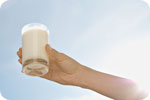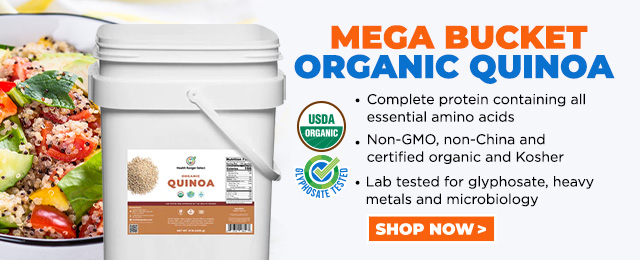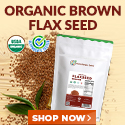
Grow Your Own Probiotics, Part 1: Kefir
Wednesday, March 12, 2008 by: Patty Donovan
Tags: kefir, probiotics, health news
- Newly released JFK files reveal Pentagon's role in creating Lyme disease and covid in the same lab
- Dr. Suzanne Humphries makes bombshell appearance on Joe Rogan podcast, exposing vaccine industry deception back to POLIOMYELITIS
- Discovery of vast underground city beneath Giza pyramids challenges human history
- Black cumin seed oil emerges as a powerful ally against breast cancer and chronic inflammation
- Catastrophic 7.7 earthquake devastates Myanmar and Thailand; death toll could reach 100,000
- The hidden battle in your glass: How A1 and A2 milk could shape your health
- Sugar-free deception: Artificial sweeteners hijack hunger signals, fuel obesity epidemic, study warns
- AI breakthrough slashes celiac disease diagnosis time from months to minutes
- Kiss Your Genetic Privacy Good-Bye! 23andMe Gets Green Light to Sell Your Intimate Genetic Details to Anyone They Want
- Europe braces for WAR as EU urges citizens to STOCKPILE FOOD, in latest provocations with Russia
- Thomas Massie’s Dual Loyalty Disclosure Act aims to restore American sovereignty by cracking down on foreign influence in Congress
- Aluminum pollution: A silent threat to human health
- Putin vows to 'finish off' Ukraine, accuses West of prolonging the war
- The mighty Eggplant: An underrated superfood with ancient roots
- The cancer fear industry: How big pharma profits from panic-and what natural alternatives offer
- Try these six natural remedies to help combat seasonal allergies
- 200 Tesla showrooms bracing for Saturday protests as movement against Musk escalates
- CIA's psychic quest for the Ark of the Covenant: Declassified files reveal bizarre Cold War experiment
- Newly released JFK files reveal Pentagon's role in creating Lyme disease and covid in the same lab
- Analysis: The coming economic collapse, a mass uprising and Trump's three secret weapons to halt the growing revolt
- Trump nominates VACCINE ZEALOT Susan Monarez to lead the CDC, sidelining RFK Jr.'s reform efforts
- Trump's greatest betrayal so far: Accelerating Middle East wars, silencing dissent, and serving Zionist masters
- Dr. Mike Yeadon releases 15-minute testimony - WATCH - about genocidal intent of COVID “vaccines”
- Festive flavors: The sweet history, nutritional profile and health benefits of pecan pie
- Elon Musk: Aliens could be here on Earth RIGHT NOW
- Big Pharma's $8 Billion bribery scheme exposed: how doctors are pushed to prescribe junk science, not heal
- 5 Simple steps to boost your brainpower: How to strengthen executive function in a distracted world
- Trump reverses course on Gaza plan, says “nobody is expelling Palestinians”
- A lack of integrity in Academia: Harvard professor found GUILTY of fraudulent research to promote CRT theory
- Reclaim your health: How midlife exercise reverses years of inactivity
- Survival 101: Effective EMF blocking techniques
- Florida takes a stand: DeSantis proposes permanent ban on mRNA vaccine mandates
- Sugarcane extract superior to cholesterol-lowering drugs?
- California's social media censorship law struck down: A victory for free speech or a threat to online safety?
- OpenAI whistleblower who dissented against how the company trained ChatGPT found dead
- EPA advisor admits the agency is funneling billions to climate groups ahead of Trump’s return to White House
- EPA advisor admits the agency is funneling billions to climate groups ahead of Trump’s return to White House
- Newly released JFK files reveal Pentagon's role in creating Lyme disease and covid in the same lab
- California's social media censorship law struck down: A victory for free speech or a threat to online safety?
- Dr. Mike Yeadon releases 15-minute testimony - WATCH - about genocidal intent of COVID “vaccines”
- The Health Ranger releases “Vaccine Zombie” song and music video, using AI-animated zombies for the music video
- The pandemic as a tool for INDOCTRINATION: Understanding “The Indoctrinated Brain” by Dr. Michael Nehls
- Florida takes a stand: DeSantis proposes permanent ban on mRNA vaccine mandates
- “Why we influenced the 2020 elections”: Facebook files reveal the coordinated effort to bury the Hunter Biden laptop story
- Mike Adams releases country western hit single: Goin’ Back in Time is Comin’ Home
- Mike Adams releases music poetry sensation: A Child of God
- Unpacking the Lies That We’ve Been Fed – new song and music video released by Mike Adams, the Health Ranger
- Michigan sheriff announces criminal investigation into 2020 election crimes, Dominion Voting Systems
- Migrants are taking advantage of recent hurricanes to scam residents and loot their homes
- House Intelligence Committee calls for the ARREST and PROSECUTION of Dr. Anthony Fauci
- RFK Jr. clears key hurdle: Sen. Susan Collins backs controversial HHS nominee, signaling a new era for health policy
- Rep. Nancy Mace introduces bill to ban biological males from female facilities on federal property
- Peter Rost exposes Big Pharma corruption in his book “The Whistleblower: Confessions of a Healthcare Hitman”
- Mike Adams releases new song and music video: Nothing More Disgusting Than a Globalist
- Red Cross issues warning to stop blood plasma donations from vaccinated people
- Scientists confirm: GENIUS brain function can be spontaneously unleashed in humans without any apparent cause
- EPA advisor admits the agency is funneling billions to climate groups ahead of Trump’s return to White House
- HYSSOP: What research reveals about the health benefits of this ancient holy herb
- Two containers with completed ballots fall out of truck in Florida
- Fully vaccinated about to see “tsunami” of illness and death, warns virologist
- Global leaders unite to clamp down on “misinformation” with UN-backed Cascais Declaration
- BREAKING: 2025 NDAA authorizes mandatory military draft of WOMEN across America… as Pentagon pursues global NUCLEAR war with both Russia and China at the same time
- Michael Yon warns of a ZIONIST TAKEOVER in Trump’s second administration
- BOMBSHELL: DNA testing kits are a SCAM to develop ethnic-specific bioweapons
- Ozempic and Wegovy weight loss drugs are injectable LIZARD VENOM PEPTIDES that may unleash a devastating wave of organ failure… side effects align with symptoms of SNAKE BITES
- Israeli soldiers accused of even more torture and abuse in the West Bank
- These 13 countries just signed an agreement to engineer a global FAMINE by destroying food supply
- NASA admits that climate change occurs because of changes in Earth’s solar orbit, and NOT because of SUVs and fossil fuels
- RFK Jr. clears key hurdle: Sen. Susan Collins backs controversial HHS nominee, signaling a new era for health policy
- Sermon 30: How Jesus reveals Caesar’s FAKE CURRENCY and FALSE AUTHORITY
- Coriander seeds: Ancient medicine backed by modern science
- Arizona officials claim Maricopa County needs 10-13 days to tabulate results of the election
The first ferment I would like to discuss is Kefir, a dairy ferment. If you are vegan, lactose intolerant or allergic to casein, please continue reading as there are alternatives to dairy ferments. Kefir is considered to be the mother culture of all dairy ferments. To quote Dominic N. Anfiteatro, who is probably the most knowledgeable person in the world today when it comes to kefir: "I regard kefir grains to be Probiotic-Jewels... and their culture-product kefir a Probiotic-Gem". I first became interested in kefir when I was reading "The Maker's Diet" by Jordan Rubin. I looked it up on the web, got some grains and I was soon making kefir. I feel it has contributed significantly to the healing I have experienced.
Kefir originated in the Caucasus Mountains. The word kefir is derived from the Turkish word keif, which loosely translates to "feeling good". This makes perfect sense as those who drink kefir regularly (myself included) claim it promotes a sense of well-being. The Caucasus peoples enjoyed longevity of over 100 years. There is a legend that kefir grains were a gift of the prophet Mohammed and the Caucasus people fiercely guarded their grains for fear they would lose their strength if given away and the secret of making kefir got out. Others heard of the "magical" properties of kefir and word spread. Even Marco Polo mentioned it. Then kefir was forgotten for centuries until news spread of its successful use in the treatment of tuberculosis, intestinal and stomach diseases. The first studies on kefir were published in Russia at the end of the 19th century. This is the true story of how kefir grains found their way to the rest of the world:
The members of the All Russian Physician's Society were determined to obtain kefir grains in order to easily supply kefir to their patients. The society approached the Blandov brothers and asked them to procure some kefir grains. These brothers not only had a dairy, but had holdings in the Caucasus. The plan was to obtain a source of kefir grains and then produce kefir on an industrial scale in Moscow. Nikolai Blandov sent a beautiful young employee, Irina Sakharova, to the court of a local prince, Bek-Mirza Barchorov. Her job was to charm the prince and persuade him to give her some kefir grains.
The prince however, afraid to violate a religious law, had no intention of giving away any 'Grains of the Prophet'. He was very taken with Irina though and didn't want to lose her. Realizing that they were not going to complete their mission, Irina and her party departed for Kislovodsk but were waylaid on way home by mountain tribesmen who kidnapped Irina and took her back to the prince. Since it was a local custom to steal a bride, Irina was told that she was to marry the prince. Only a daring rescue mission mounted by agents of her employers saved Irina from the forced marriage. The unlucky prince was hauled before the Tsar who ruled that the prince was to give Irina ten pounds of kefir grains, to recompense her for the insults she had endured. The kefir grains were taken to the Moscow Dairy and in September, 1908, the first commercial kefir was sold.
Traditionally kefir is prepared by fermenting milk with kefir grains. The word 'grains' is a bit misleading. They look like little pieces of cauliflower and have absolutely no relationship to cereal grains. They are composed of a firm gel-like mass of proteins, fats and polysaccharides and reproduce in a dairy medium. The organisms found in kefir can be divided into 4 genus groups: Lactobacilli, Streptococci-Lactococci, Acetobacter and Yeasts. Kefir, prepared with grains, contains as many as 35 different strains of bacteria and yeast. Commercial powdered starters are available and these contain 10-15 organisms, while the bottled kefir you buy in the store contains a maximum of 10 strains (along with a lot of things you don't want). Most bottled kefir contains only bacteria as many states do not allow the selling of beverages with live yeasts, so, as you can see, if you want kefir for its probiotic value, it only makes sense to culture your own. It is very simple to do, taking about 5 minutes a day. It is also quite simple to prepare cheese from kefir.
Kefir has a creamy consistency with a slightly tangy (sour) taste depending on how long it's been fermented. Mine often gets as thick as yogurt. Many, if not most people drink kefir after culturing for 24 hours then straining. However, by doing this they are missing out on many of the benefits of kefir. For example, by ripening kefir another 24 hours, the content of folic acid is increased 116%. Kefir was originally stored in airtight clay vessels or wooden barrels and allowed to age. This produced a very effervescent beverage with up to 2% alcohol.
Besides kefir's obvious probiotic value, it possesses other healing properties. Kefir grains produce a polysaccharide known as kefiran. Research in Japan found that rats with tumors, which were fed kefiran, had reduction in tumor size. Kefiran is also proving to have anti-inflammatory properties. Dom, mentioned above, actually cured himself of Crohn's disease by both eating kefir grains and inserting them rectally. He has also had success treating Repetitive Stress Injuries through the ingestion of kefir grains. In 2003, the anti-inflammatory effect of kefiran was investigated and correlated scientifically by Prof. Jose M. Schneedorf et al.
Other research shows regularly eating the grains themselves can lower blood pressure, cure constipation, and control blood glucose. On his site, Dom stresses that anyone culturing kefir should also ingest excess grains. On Dom's advice, a friend saved grains until she had a large quantity, then started giving her autistic son about a tablespoonful of grains with every meal. They are now about 3 weeks into this process and her son is responding beautifully. He is much calmer, emotionally less volatile and he is actually taking classes online. He is 11 years old. Currently, there is no scientific research using kefir grains to combat autism, but anecdotally, both with my friend and with others, it appears to hold promise. Kefir and kefir grains can also greatly aid in the elimination of Candidiasis.
There is a common misconception among most people battling Candida and most Candida diets that all yeasts are bad and that fermented foods will make you sicker. This simply isn't true when talking about live lacto-fermented foods. Yeasts are in the air so every time we breathe or swallow, we are putting yeasts in our bodies. There is no way to avoid exposure to yeasts unless you live in a bubble. If all yeasts were bad, we couldn't survive. Candida albicans is a normal part of microbial flora in the intestines and only causes problems when its growth gets out of control. Sadly, the SAD (Standard American Diet) is the perfect vehicle to stimulate massive proliferation of Candida albicans.
Candida is normally a smooth rounded bud and is harmless in this stage. When the colony reaches a "critical mass" in the large intestine and is running out of food, Candida has the ability to morph from the round bud to a thread-like shape. It then migrates to the small intestine in search of food and this is where the threads are able to wreak havoc by poking holes in the small intestine. Instead of vital nutrients being absorbed by the small intestine, approximately 180 toxins produced by Candida are given direct access to the bloodstream. This phenomenon is called leaky gut syndrome. Undigested food particles, toxins and other chemicals all cause inflammatory reactions once outside the protected confines of the intestines and this inflammation is the cause of myriad diseases and syndromes.
Unfortunately, mainstream medicine refuses to recognize the role of Candida in inflammation.
The yeasts and bacteria present in kefir and other lacto-fermented foods are actually able to displace Candida on the intestinal wall allowing these holes to heal. Once the leaky-gut is resolved and toxins no longer pass into the bloodstream and tissues of the body, healing can begin. I truly believe that lacto-fermented foods are key players in combating Candida albicans overgrowth and dairy kefir provides the most comprehensive combination of beneficial organisms.
Milk kefir grains can be used to ferment alternative milks such as soy milk, seed/nut milks, quinoa milk, coconut and rice milk. The grains will not grow in such mediums and will eventually stop fermenting, and kefiran is not produced. You do however; reap all the other benefits, especially the probiotic benefits of fermenting milk. Another alternative is water kefir. Water kefir grains are like squishy crystals and are used to ferment sugar, water and fruits. You can create your own carbonated soda-like beverages with water kefir and get many of the same probiotic benefits. The organisms are not identical to milk kefir grains. You can convert milk grains to culture other mediums, but water grains don't generally do a good job with dairy. For more information on this:
(http://users.chariot.net.au/~dna/kefirpage.h...) .
While kefir will work with all milk, even powdered, it does like a little fat. I would highly recommend raw milk (cow or goat) from grass fed animals. If you can't get raw, try and find milk that has been pasteurized but not homogenized. Ultra pasteurization is the most damaging to the structure of the milk proteins, but that is often the only way you can get organic milk. Above all, avoid milk that comes from cows given hormones and antibiotics. Again, kefir grains will do their magic with any milk.
If you are interested in finding raw milk in your area, go here: (http://www.realmilk.com/where.html) .
If you are lactose intolerant, the initial 24-hour fermentation will remove about 50% of the lactose, which is the food for the organisms. Ripening the kefir after straining for an additional 24 hours at room temperature or for several days in the refrigerator, will remove almost all the lactose. Many people who are lactose intolerant are able to drink raw milk even without fermenting, as the enzyme lactase is still present.
I hope I have piqued your curiosity about kefir and tempted you to try it. Here are some resources for getting grains. Most people give you the grains for the cost of shipping.
(http://groups.yahoo.com/group/Kefir_making/) , Join this group, post stating where you are and ask.
(http://groups.yahoo.com/group/Kefir_making/d...)
(http://www.torontoadvisors.com/Kefir/kefir-l...)
For some people, the tart taste may take a little getting used to. Here are a couple of recipes I've developed for smoothies. I use stevia because I have eliminated all sugars from my diet, however, you can use honey or another natural sweetener of choice.
Mint Chocolate Smoothie
8 to 10 oz KEFIR
1 heaping tablespoonful Cocoa Powder
¼ teaspoonful Peppermint Extract
1 raw egg
1 tablespoonful Chia seed
Stevia to taste
Blend and enjoy
Berry Smoothie
8 to 10 oz KEFIR
¼ cup berries of choice
½ teaspoonful Vanilla Extract
1 raw egg
1 tablespoonful Chia seed
Stevia to taste
Blend and enjoy
(http://users.chariot.net.au/~dna/kefirpage.h...)
(http://www.healingcrow.com/ferfun/ferfun.htm...)
(http://www.kefir.biz/history.htm)
(http://www.know-the-cause.com/NewsLetterArti...)
About the author
Patty Donovan was in a wheelchair and could only walk around her house with a cane. She was on over 20 medications. When told to "take the morphine, get in the wheelchair and learn to live with it" by a neurosurgeon, she knew her life had to change. She is now almost a fanatic when it comes to healing through the use of "whole foods" and and natural remedies. Since that time, she has spent countless hours researching nutrtion and alternative health. After spending 30 years in the allopathic health care industry in both pharmacy and as an RN, she brings a unique perspective to Natural News readers. Since committing to this new life style, she no longer uses even a cane, has gotten off over 20 medications, lost over 50lbs and returned to work.Kefir at FETCH.news
Get independent news alerts on natural cures, food lab tests, cannabis medicine, science, robotics, drones, privacy and more.
Take Action: Support Natural News by linking to this article from your website
Permalink to this article:
Embed article link: (copy HTML code below):
Reprinting this article:
Non-commercial use OK, cite NaturalNews.com with clickable link.
Follow Natural News on Facebook, Twitter, Google Plus, and Pinterest
Science News & Studies
Medicine News and Information
Food News & Studies
Health News & Studies
Herbs News & Information
Pollution News & Studies
Cancer News & Studies
Climate News & Studies
Survival News & Information
Gear News & Information
News covering technology, stocks, hackers, and more



"Big Tech and mainstream media are constantly trying to silence the independent voices that dare to bring you the truth about toxic food ingredients, dangerous medications and the failed, fraudulent science of the profit-driven medical establishment.
Email is one of the best ways to make sure you stay informed, without the censorship of the tech giants (Google, Apple, Facebook, Twitter, YouTube, etc.). Stay informed and you'll even likely learn information that may help save your own life."
–The Health Ranger, Mike Adams












































